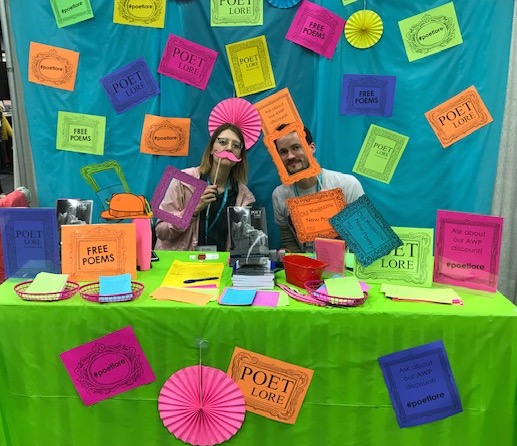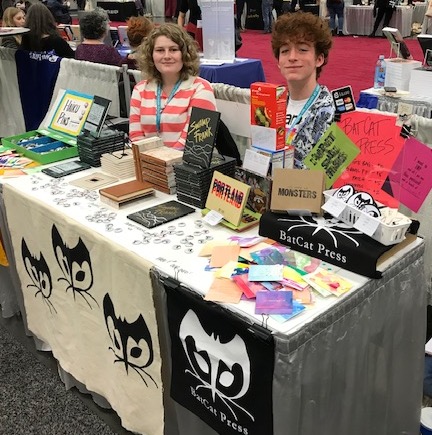
This blog posts on Mondays. Second Mondays of the month I devote to my writing workshop students and anyone else interested in creative writing. Welcome!
> For the archive of workshop posts click here.
Now that anyone and everyone and their dog, cat, budgie, llama, and chartreuse polkadot giraffe can start a blog, or for that matter an online magazine (dub your blog an online magazine, pourquoi pas?), I am rarely asked, with that gaze of yearning, as I so often was twenty years ago, how can I get published? These days, um, lift a finger and click “publish.”
Nonetheless it remains a fact that for most poetry, short stories, and literary essays, discerning readers will be easier to come by when said work is brought out not by its author, but by a print magazine or imprint of repute. (There are exceptions, but that would be another blog post.)
Back at the end of March I attended the annual AWP bookfair— this is the biggest litmag scene in the US– and what struck me about it was how little things had changed in the past 20 years. There were Poet Lore, the Paris Review, Fourth Genre, Creative Nonfiction— a whole host of venerable litmags that have been around since forever. (In the case of Poet Lore, that would be 1889.)

Certainly, there have been some changes. Back when, in pre-website times, most editors disdained emailed submissions; now most solicit electronic submissions, and oftentimes via submittable.com. (Does anyone under the age of 25 even know what an SASE* is?) It is no longer considered beyond the pale for a reputable litmag to charge for submissions. (Two dollars there, three dollars here… it adds up for writers…. and so a litmag can cover at least some fraction of their costs. Such are the economics…)
*Self-Addressed Stamped Envelope.
More changes I noted at the AWP bookfair: a good number of writers, and not necessarily the younger ones, now sport green hair and tattoos. Smombies hither & yon.
And of course, all the litmags now have their websites, Twitter, FaceBook page, YouTube, mailing list, etc.
But on the whole the bookfair’s tables and booths looked much as they would have in 1999. The better litmags still bring out print editions, their editors having selected the contents from titanic “slush piles” of unsolicited submissions– albeit these slush piles are largely electronic now.
The USA in its every corner and cranny suffers no shortage of poets or literary writers! So getting your piece published by a reputable literary magazine is still, more often than not, a head-banger of a challenge. It takes discernment; and, barring lucky stars (and I don’t mean the cereal with those crappy marshmallows), a champion athlete’s ability to not take rejection personally and, like a certain senator, to nevertheless persist; and, less glamorously, but vitally, following editors’ submissions requirements and keeping an eye out for their calls for submissions.
I have plenty more to say about publishing in literary magazines, however, I have already said it! This second Monday I am hereby point to an old (but updated) article I wrote for the John Hopkins University Part-Time Writing Program newsletter, “Out of the Forest of Noise: On Publishing the Literary Short Story” –all of which advice also applies to poetry and literary short essay, and translations into English of same.
BATCAT PRESS’ CALL FOR SUBMISSIONS
Before getting to that dusted-off article, however, I must mention something I saw at AWP such as I had never seen before: BatCat Press’ coyly playful call for submissions, not the usual boring old flyer, but a little gift of “book art” in itself.

As I mentioned in last month’s post on AWP, BatCat Press is a book arts press run by highschool students– something very unusual to see at AWP. And the quality of their publications is impressive. Viva!
Here’s how they describe themselves:
“From stitching books by hand to marbling paper, letterpress printing, and beyond, BatCat Press has been at the creative edge of small press publishing since 2009. We work with authors at various points in their writing careers, seeking work that suggests physicality and broad appeal. We publish our titles as hardbound limited editions, all produced in-house by our staff of dedicated high school students.”
This is their “call for submissions”:






OK… Now, from my archives:
OUT OF THE FOREST OF NOISE:
ON PUBLISHING THE LITERARY SHORT STORY
From The Part Times, a newsletter of the M.A. in Writing Program, Zanvyl Krieger School of Arts and Sciences, Johns Hopkins University, Fall 2001 (with some minor edits and updates). Last updated: February 2018
So you want to get your short story published. Take heart: you can do it. And, if your work is worthy— a question only you can answer— it merits the effort. Like a boat, send it out where it belongs, over the great wide sea. Let it find readers, whoever they may be, on whatever strange shores. Some of your readers may not be born yet. It helps to keep that in mind.
Beginning writers often imagine publishing their short story to be a glamorous event, Hemingwayesque in a wear-your-sunglasses-and-knock-back-the-grappa-as-agents-ring-your-phone-off kind of way. But for most writers it’s an experience on par with, say, folding laundry. Unless you make one of the slicks— The New Yorker, Esquire, Atlantic Monthly, Harper’s— most likely your payment will be two copies of the magazine. These will arrive in your mailbox in a plain brown envelope. Some editors jot a thankyou note, but most don’t bother. Chances are, your friends and family will not have heard of the magazine. Even the best literary journals often manage only a modest circulation— 500 to 5,000— and may not be available for sale except in a very few widely scattered off-beat independents. In short, if you want money, you’d do better to flip burgers, and if you want attention, go fight bulls. Knock back that grappa, heck, wear a spangled pink tutu and splash in the Dupont Circle fountain during lunch hour. Scream obscenities in Swahili. Whatever.
So why try? Because when your story is published it is no longer one copy printed out from your printer, but 1,000 or more. Perhaps one is lying on someone’s coffee table in Peterborough, New Hampshire, or on a poet’s broad oak desk overlooking the beach at La Jolla, California. Maybe one sits on the shelves at the University of Chicago’s Regenstein Library, or on a side table in the lobby at Yaddo. Perhaps a dentist will read your story, or a retired school teacher from Winnetka. Perhaps one day, a hundred years from now, a bizarrely tattooed highschool student will find it on a shelf in the basement of the Reno, Nevada public library, and she will sit down Indian-style on the cold linoleum floor and read it, her eyes wide with wonder. Your story, once published, lives its own life, sinking some deep, strange roots. Potentially forever. [>> CONTINUE READING THIS ARTICLE ON WWW.CMMAYO.COM]

A Review of Claudio Saunt’s West of the Revolution: An Uncommon History of 1776
Find out more about C.M. Mayo’s books, shorter works, podcasts, and more at www.cmmayo.com.

